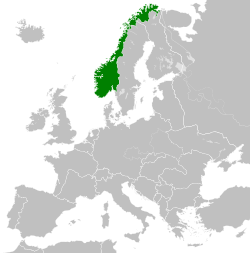Říšský komisariát Norsko
| Říšský komisariát Norsko Reichskommissariat Norwegen
| |||||||
geografie
| |||||||
Oslo | |||||||
| obyvatelstvo | |||||||
norština, němčina | |||||||
| státní útvar | |||||||
civilní okupační správa | |||||||
říšský komisař: | |||||||
předseda vlády: | Vidkun Quisling (1942-1945) | ||||||
vznik: | 24. dubna 1940 | ||||||
zánik: | 9. května 1945 | ||||||
| státní útvary a území | |||||||
| |||||||
Říšský komisariát Norsko (německy Reichskommissariat für die besetzten norwegischen Gebiete, zkráceně Reichskommissariat Norwegen) byla územně správní jednotka nacistického Německa na území okupovaného Norska během let 1940 až 1945.
Po německém obsazení Norska se v zemi pokusil převzít moc fašista Vidkun Quisling. Hitler ovšem dosadil k moci německého říšského komisaře Josefa Terbovena. Quisling zprvu žil v ústraní, ale v roce 1942 se stal loutkovým vůdcem. Po osvobození Norska v roce 1945 byl Quisling popraven.
Média použitá na této stránce
National flag and merchant ensign of Germany from 1933 to 1935.
National flag and merchant ensign of Germany from 1933 to 1935.
Autor: TRAJAN 117, Licence: CC BY-SA 3.0
Reichskommissariat Norwegen in 1942.
The Imperial Eagle or Emblem of the German Empire (German Reich, used 1935–1945), which features an eagle looking over its right shoulder, that is, looking to the left from the viewer's point of view. It is similar to the Parteiadler or Emblem of the Nationalsozialistische Deutsche Arbeiterpartei (NSDAP; known in English as the National Socialist German Workers' Party, or simply the Nazi Party), but the eagle of the latter is looking over its left shoulder, that is, looking to the right from the viewer's point of view.






